Glass Onion Nails It: Policymakers Need to Check Receipts on the Hydrogen Hype
Netflix’s juicy mystery veers close to reality when it comes to the pitfalls of hydrogen — which is no silver bullet for our climate crisis.

This page was published 2 years ago. Find the latest on Earthjustice’s work.
Glass Onion isn’t just a hilarious comedy with a knock-out cast. It’s also a pretty darn good allegory for how the charlatans in the fossil fuel industry push hydrogen as the answer to all our energy and climate challenges.
The plot of Glass Onion revolves around tech billionaire Miles Bron’s ambitions to power the world with a made-up hydrogen product called Klear — a plan that literally blows up in his face. There’s some fun science fiction at play here — storing hydrogen in a room-temperature crystal like Klear isn’t a thing. But the movie illustrates some of the all-too-real dynamics in today’s energy debates.
Pushing for the most ludicrous uses of hydrogen first
You’d think the last place to install a risky new technology would be in peoples’ homes, but it’s the first use Miles Bron opts for, ignoring the challenges and safety risks involved in getting Klear in every household in the country. It’s eerily similar to the way gas companies promote hydrogen as a fuel for home appliances.

Edward Norton as Miles Bron and Daniel Craig as Benoit Blanc in Glass Onion: A Knives Out Mystery. (Netflix)
So, why is using hydrogen in homes such a bad idea? First, action on the climate crisis can’t wait and it won’t be feasible to use pure hydrogen at home for the foreseeable future. Gas-burning appliances on today’s market were designed to burn methane and can’t operate on pure hydrogen without an unacceptable risk of explosions. Likewise, the gas pipelines in homes and utility systems aren’t compatible with pure hydrogen. The fastest way to tackle pollution from home appliances is by switching to modern electric appliances, like heat pumps and induction stoves, and quickly transitioning to renewable electricity.
Second, even if hydrogen were an option, zero-emission electric appliances would be the better choice for people who want to save money on fuel and breathe clean air. Green hydrogen is produced by using renewable electricity to split water molecules, but the most economical way for home appliances to use renewable energy is to plug directly into a clean power grid. A green hydrogen furnace would require about six times as much wind and solar energy as a modern heat pump space heater. If that weren’t enough, any equipment that burns gas — whether methane or hydrogen — produces lung-damaging air pollution, but electric appliances don’t.
There are some smart uses for truly green hydrogen, like using it to replace all the fossil-derived hydrogen that industry uses today as a feedstock for fertilizer production. There are some sectors where it’s unclear how well hydrogen will be able to compete against other decarbonization strategies, like long-haul trucks and trains. And there are plenty of places where it would be a waste of time and money to use hydrogen because there are cheaper zero-emissions alternatives available today. Unfortunately, it’s these sectors — like home energy and cars — where the fossil fuel industry is most aggressively hyping hydrogen, precisely in order to stall a rapid transition away from fossil fuels.
Bottom line: Like Miles Bron, the fossil fuel industry is hyping hydrogen loudest where it makes the least sense.
The smoke and mirrors around how industry produces its so-called “clean” hydrogen
We don’t know how Miles Bron makes Klear, and that’s part of the point. Miles pitches his wealthy and powerful friends on Klear as an almost magical, silver-bullet energy source that can solve the climate crisis and be made burden-free from abundant seawater. There is a bit of reality here: The only zero-emissions strategy for producing hydrogen is using renewable energy to split water molecules, good old H20 — though this process is no free lunch, requiring massive amounts of energy.

Nearly all the hydrogen sold in California is produced from fossil gas, but industry often buys biogas credits from out-of-state entities like factory farms and calls it “renewable.”
Miles Bron’s vague description about how he makes Klear mirrors the often-scant details we get from the fossil fuel industry when they claim their hydrogen is “clean” or “renewable.” When we take a closer look, this claim often relies on a variety of greenwashing schemes to mask hydrogen production’s heavy toll on our climate. For instance, industry is pressuring the Treasury Department to give “clean hydrogen” production tax credits to companies that use dirty grid electricity to make hydrogen if they buy “renewable energy credits” to create a legal fiction that they used wind or solar energy.
The Biden administration should reject these requests to avoid giving tax credits for hydrogen fuels that make the climate crisis even worse. If industry uses fossil-powered electricity for the energy-intensive process of splitting water molecules, the hydrogen fuel it produces is even more carbon-intensive than fossil fuels like gasoline, diesel, and fracked gas. Encouraging industry to scale up its production of hydrogen from polluting processes could have truly devastating consequences for the planet. Today, hydrogen production alone produces more climate pollution than the entire nation of Germany because industry produces so much hydrogen from fossil fuels.
Bottom line: The details on how industry produces hydrogen make a profound difference for the climate and public health, and industry does *not* want the government paying close attention.
Policymakers can be mesmerized by the hydrogen hype
An underlying thread in Glass Onion is Miles Bron’s coziness with people in the government who should have scrutinized his lofty claims, but didn’t. His hydrogen technology could only endanger people in the United States if the government failed to do its job. Even in the real world, government officials can be too quick to accept hydrogen hype, such as the UK energy minister who is promoting hydrogen as a “silver bullet.”
Bottom line: Policymakers should do the necessary detective work when it comes to hydrogen. For one thing, folks can start untangling the industry spin by reading our report, “Reclaiming Hydrogen for a Renewable Future.” As the Biden administration implements hydrogen-boosting provisions of the Bipartisan Infrastructure Framework and the Inflation Reduction Act, we’ll be paying close attention and fighting undue industry influence. In nearly all cases when it comes to transportation and our homes, electric technology already available today is the most efficient, climate-friendly upgrade.
Earthjustice’s Clean Energy Program uses the power of the law and the strength of partnership to accelerate the transition to 100% clean energy.